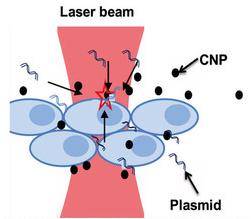A team of physicists at the University of Texas (UT) recently reported success coupling continuous wave near-infrared laser beams with crystalline magnetic carbon nanoparticles to introduce therapeutic agents into cancer cells. The study, which appears in “Nature Scientific Reports,” introduces an alternate and viable approach to cell targeting and drug delivery methods.
Crystalline magnetic carbon nanoparticles
The nanoparticles developed as part of the study are crystalline magnetic carbon nanoparticles (CMCNPs) varying in size from 5 to 20 nm. Because carbon has inherently strong absorption properties in the near-infrared range, irradiation of the particles creates a rise in temperature that results in several effects on cells in the particle’s vicinity, including cell-membrane stretching and increased fluid flow. Both of these effects enhance permeability and facilitate delivery of exogenous substances. The crystalline nature of the nanoparticles affords stability, rendering the particles non-reactive and minimizing their toxicity. Their ferromagnetic properties allow them to be directed to a target site via an external magnetic field.
The research team, headed by UT physics professors Dr. Samarendra Mohanty and Dr. Ali Koymen, previously used magnetic carbon nanoparticles to target cancer cells for photothermal destruction. In the current study, however, they make use of CMCNPs to facilitate the directed delivery of exogenous agents.
Continuous wave near-infrared laser beams
Near-infrared (NI) beams are less susceptible than UV-visible range beams to absorption and scattering by cellular components. As such, NI is preferred when dealing with a three-dimensional environment such as tissue. Typically, in order to perforate the cellular membrane, it is necessary to employ high peak intensity ultrafast NI beams. This is not feasible in vivo for a number of reasons, including operational difficulties and the possibility of damage to non-targeted cells. Thus, researchers employed photothermal agents in the form of the aforementioned CMCNPs, which allow the photodelivery to be carried out using a lower-intensity continuous wave laser beam.
Using their photothermal delivery protocol, researchers reported the successful introduction of impermeable dyes and plasmid DNA into cancer cells in vitro. The results have promising implications for in vivo treatments and applications, including remotely guided drug delivery of cytotoxic chemotherapeutic agents. The possibilities range in scope from vaccinations to gene therapy. What’s more, the particle’s fluorescent properties make them highly suitable for use in medical imaging applications.
Researchers are optimistic about the reproducibility of their findings in vivo. The full report Crystalline magnetic carbon nanoparticle assisted photothermal delivery into cells using CW near-infrared laser beam is available at the Nature Scientific Reports website.
Related news:





